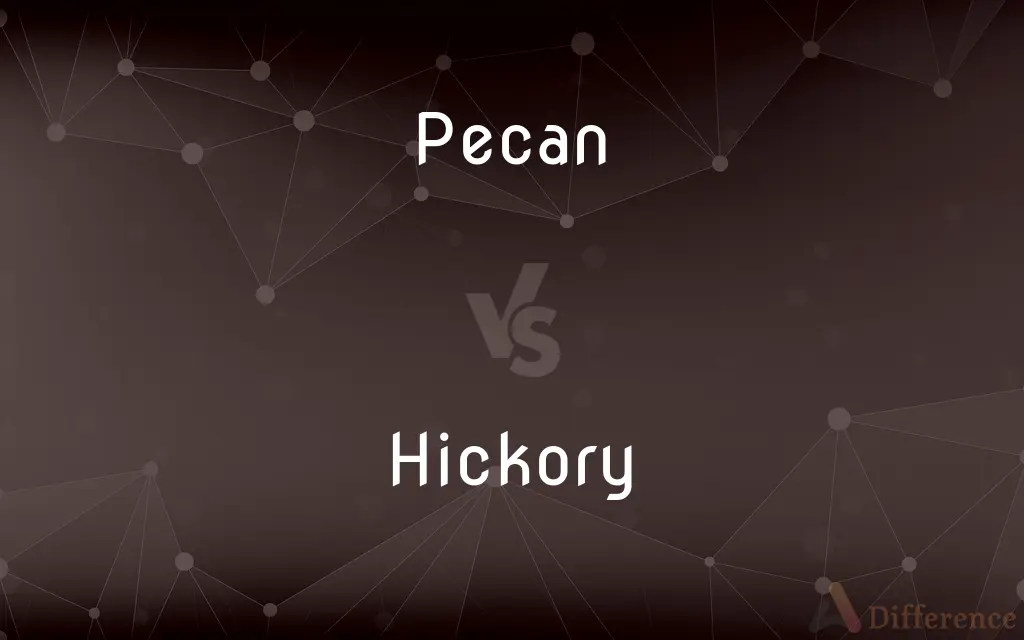Pecan vs. Hickory — What's the Difference?
By Tayyaba Rehman & Urooj Arif — Updated on April 7, 2024
Pecan is a type of tree known for its edible nuts, while Hickory encompasses a broader category of trees, some of which yield edible nuts and others valued for their wood.

Difference Between Pecan and Hickory
Table of Contents
ADVERTISEMENT
Key Differences
Pecan trees are a species within the Hickory genus, specifically known for producing pecan nuts, a popular ingredient in various culinary dishes, especially desserts like pecan pie. Hickory trees, on the other hand, include several species, some of which produce edible nuts, but are more widely recognized for their hard, durable wood used in furniture, tools, and smoking meats.
The pecan tree, native to the southern United States and Mexico, thrives in warm climates and is extensively cultivated for its nuts. Hickory species are found across a broader range in the United States, with certain types like the shagbark and shellbark hickory also producing edible nuts, albeit less commonly consumed than pecans.
Pecan nuts are distinguished by their sweet, buttery flavor and are used in a wide range of recipes, from savory dishes to sweet treats. Hickory nuts, particularly from the shagbark and shellbark hickory, are also edible and prized for their rich, distinctive flavor, though they are not as widely available commercially as pecans.
In terms of wood, pecan wood is a type of hickory wood, known for its strength and flexibility, making it valuable for use in furniture and flooring. Hickory wood, more generally, is esteemed for its exceptional strength and shock resistance, qualities that make it ideal for tool handles, sports equipment, and barbecue smoking wood.
Both pecan and hickory trees contribute significantly to ecosystems, providing habitat and food for wildlife. However, the pecan tree holds particular cultural and economic importance in the southern United States, symbolizing the region's agricultural heritage and contributing significantly to local economies.
ADVERTISEMENT
Comparison Chart
Type
A species within the Hickory genus.
A genus including several species.
Known For
Edible nuts.
Edible nuts (in some species) and durable wood.
Habitat
Southern United States and Mexico.
Broadly across the United States.
Nut Flavor
Sweet and buttery.
Rich, varies by species; less commonly consumed than pecans.
Wood Usage
Furniture, flooring.
Tool handles, furniture, smoking meats.
Economic Impact
Significant in regions where cultivated.
Valuable for both nuts (select species) and wood.
Cultural Significance
Symbol of southern U.S. agriculture.
Widely recognized for wood’s utility in various applications.
Compare with Definitions
Pecan
Culinary Uses.
Pecans are a key ingredient in traditional southern pies.
Hickory
Wood Value.
Hickory wood is prized for its strength and shock resistance.
Pecan
Climate Preference.
Pecan trees require long, warm growing seasons.
Hickory
Range of Uses.
From tool handles to smoking meats, hickory wood is versatile.
Pecan
Wood Characteristics.
Pecan wood is durable and flexible, suitable for furniture.
Hickory
Broad Genus.
The Hickory genus includes species like shagbark and shellbark.
Pecan
Wildlife Benefits.
Pecan trees provide food for birds and mammals.
Hickory
Nut Variety.
Hickory nuts are used in some traditional recipes.
Pecan
Nut Production.
Pecan orchards are a significant agricultural industry in Texas.
Hickory
Ecosystem Role.
Hickory forests support diverse wildlife habitats.
Pecan
The pecan (Carya illinoinensis) is a species of hickory native to the southern United States and northern Mexico in the region of the Mississippi River. The tree is cultivated for its seed in the southern United States, primarily in Georgia, New Mexico, and Texas, and in Mexico, which produces nearly half of the world total.
Hickory
Hickory is a common name for trees comprising the genus Carya, which includes around 18 species. Five or six species are native to China, Indochina, and India (Assam), as many as twelve are native to the United States, four are found in Mexico, and two to four are from Canada.
Pecan
A deciduous tree (Carya illinoinensis) of the central and southern United States, having deeply furrowed bark, pinnately compound leaves, and edible nuts.
Hickory
Any of several chiefly North American deciduous trees of the genus Carya, having smooth or shaggy bark, pinnately compound leaves, and hard smooth nuts, each containing an edible seed and surrounded by a husk that splits into four valves.
Pecan
The smooth, thin-shelled oval nut of this tree.
Hickory
The tough, heavy wood of one of these trees.
Pecan
A deciduous tree, Carya illinoinensis, of the central and southern United States, having deeply furrowed bark, pinnately compound leaves, and edible nuts.
Hickory
A walking stick or switch made from such wood.
Pecan
A smooth, thin-shelled, edible oval nut of this tree.
Hickory
Of or pertaining to the hickory tree or its wood.
Pecan
A half of the edible portion of the inside of this nut.
Hickory
(countable) Any of various deciduous hardwood trees of the genus Carya or Annamocarya.
Pecan
A species of hickory (Carya olivæformis), growing in North America, chiefly in the Mississippi valley and in Texas, where it is one of the largest of forest trees; also, its fruit, a smooth, oblong nut, an inch or an inch and a half long, with a thin shell and well-flavored meat.
Hickory
Carya illinoinensis is the source of pecan nuts.
Pecan
Wood of a pecan tree
Hickory
(uncountable) The wood of these trees.
Pecan
Tree of southern United States and Mexico cultivated for its nuts
Hickory
A coarse, durable cotton fabric.
The loggers wore hickory shirts.
Pecan
Smooth brown oval nut of south central United States
Hickory
A club made from this wood.
Hickory
An American tree of the genus Carya, of which there are several species. The shagbark is the Carya alba, and has a very rough bark; it affords the hickory nut of the markets. The pignut, or brown hickory, is the Carya glabra. The swamp hickory is Carya amara, having a nut whose shell is very thin and the kernel bitter.
Hickory
Valuable tough heavy hardwood from various hickory trees
Hickory
American hardwood tree bearing edible nuts
Common Curiosities
How does hickory wood compare to other woods?
Hickory wood is known for its exceptional strength, durability, and shock resistance.
What is the primary use of pecan trees?
Primarily for nut production, with pecans used in various culinary applications.
What makes hickory wood preferred for smoking meats?
Its dense structure and unique flavor profile impart a distinctive taste to smoked meats.
What distinguishes pecan nuts from other tree nuts?
Their sweet, buttery taste and soft texture set them apart from other nuts.
How does the climate affect pecan cultivation?
Pecans require a warm climate with a long growing season for optimal production.
Can you eat hickory nuts?
Yes, some hickory species produce edible nuts, though they're less common than pecans.
What's the ecological impact of hickory and pecan trees?
They provide essential habitat and food for wildlife, supporting biodiversity.
Is hickory wood used in any specific industries?
Beyond furniture and barbecue, it's used in sports equipment and tool handles for its resilience.
Why are pecans more popular than hickory nuts?
Pecans have a sweeter, more versatile flavor and are more readily available commercially.
Why is pecan wood included under hickory in wood categorizations?
Because pecan trees are a species within the Hickory genus, sharing many wood characteristics.
Are pecan trees found outside the United States?
While native to the southern U.S. and Mexico, pecan trees are cultivated in other warm climates globally.
How are pecans harvested?
Pecans are typically harvested mechanically from the ground after they fall from the tree.
What's the difference in nut harvesting between pecan and hickory trees?
Pecan harvesting is more commercialized and mechanized, whereas hickory nut collection is often more artisanal or for personal use.
Can all hickory nuts be eaten?
While all are technically edible, not all are palatable or easy to crack open.
What cultural significance do pecan trees hold?
Pecan trees symbolize the agricultural heritage of the southern United States, notably in states like Georgia and Texas.
Share Your Discovery

Previous Comparison
Analyst vs. Officer
Next Comparison
Antipathy vs. ApathyAuthor Spotlight
Written by
Tayyaba RehmanTayyaba Rehman is a distinguished writer, currently serving as a primary contributor to askdifference.com. As a researcher in semantics and etymology, Tayyaba's passion for the complexity of languages and their distinctions has found a perfect home on the platform. Tayyaba delves into the intricacies of language, distinguishing between commonly confused words and phrases, thereby providing clarity for readers worldwide.
Co-written by
Urooj ArifUrooj is a skilled content writer at Ask Difference, known for her exceptional ability to simplify complex topics into engaging and informative content. With a passion for research and a flair for clear, concise writing, she consistently delivers articles that resonate with our diverse audience.
















































